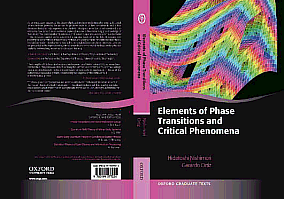Elements of Phase Transitions and Critical Phenomena
Hidetoshi Nishimori and Gerardo Ortiz
Published by Oxford University Press
(30% discount with promo code ASPROMP8)

Hidetoshi Nishimori and Gerardo Ortiz
Published by Oxford University Press
(30% discount with promo code ASPROMP8)

Preface
Chapter 1: Phase transitions and critical phenomena
- Phase and phase diagram
- Phase transitions
- Critical phenomena
- Scale transformation and renormalization group
- Ising model and related systems
Chapter 2: Mean-field theories
- Mean-field approximation
- Critical exponents of the mean-field theory
- Landau theory
- Landau theory of the tricritical point
- Infinite-range model
- Variational method
- Antiferromagnetic Ising model
- Bethe approximation
- Correlation function
- Limit of applicability of the mean-field approximation
- Dynamic critical phenomena
Chapter 3: Renormalization group and scaling
- Coarse-graining and scale transformations
- Parameter space and renormalization group equation
- Renormalization group flow near a fixed point and universality
- Scaling law and critical exponents
- Scaling law for correlation functions and hyperscaling
- A simple example: One-dimensional Ising model
- Mean-field theory and scaling law
- Scaling dimension and scaling law
- Scaling and anomalous dimension
- Data analysis by scaling law and finite-size scaling
- Crossover phenomena
- Dynamic scaling law
Chapter 4: Implementation of renormalization group
- Real-space renormalization group for arbitrary dimensions
- Momentum-space renormalization group: epsilon=4-d expansion
- Real-space renormalization group for a quantum system
Chapter 5: Statistical field theory
- From bits to fields
- Continuum limit and field theory
- Hubbard-Stratonovich transformation
- Integrating out degrees of freedom: Coarse graining
- Phenomenological Landau-Ginzburg approach
- Symmetry and its breakdown
- Nambu-Goldstone modes
- Topological defects
Chapter 6: Conformal field theory
- From scale invariance to conformal symmetry
- Conformal transformations
- Primary and quasi-primary operators
- Energy-momentum tensor and the Ward identity
- Virasoro algebra
- Gaussian theory
- Operator formalism
- Unitary representation of the Virasoro algebra
- Ising model
- Finite-size effects
Chapter 7: Kosterlitz-Thouless transition
- Peierls argument
- Lower critical dimension of the XY model
- Mermin-Wagner theorem: Absence of spontaneous magnetization
- Kosterlitz-Thouless transition
- Interaction energy of vortex pairs
- Renormalization group analysis
- Lattice gauge theory and Elitzur's theorem
Chapter 8: Random systems
- Random fields
- Spin glass
- Diluted ferromagnet and percolation
Chapter 9: Exact solutions and related topics
- One-dimensional Ising model
- One-dimensional n-vector model
- Spherical model
- One-dimensional quantum XY model
- Two-dimensional Ising model
- Zeros of the partition function
Chapter 10: Duality
- Classical duality
- High- and low-temperature series expansions
- Duality by Fourier transformation
- Quantum duality
Chapter 11: Numerical methods
- Master equation
- Monte Carlo simulation
- Numerical transfer matrix method
Appendixes
- Saddle-point method
- Expressing the susceptibility in terms of correlation functions
- Rushbrooke's inequality
- Cumulants
- Renormalization group equations from the epsilon expansion
- Symmetry and Noether's theorem
- Basics of group theory and Lie algebras
- Basics of homotopy theory
- Restrictions on the type of conformal mappings
- Properties of the energy-momentum tensor
- Energy-momentum tensor of the Gaussian theory
- Existence of spontaneous magnetization in the two-dimensional Ising model
- Quantum version of the Mermin-Wagner theorem
- Replica symmetric solution of the SK model
- Integral for the partition function of the n-vector model
- Multiple Gaussian integral and lattice Green function
- Jordan-Wigner transformation
- Proof of Theorem 9.1
- Poisson summation formula
- Sample codes for Monte Carlo simulation of the Ising model
Solutions to exercises
For further reading
Index